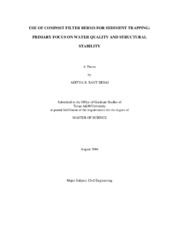| dc.description.abstract | Runoff from road construction and maintenance sites is responsible for erosion and deposition of sediments in the receiving water bodies. In addition to soil particles from erosion, runoff also transports other pollutants such as rubber, toxic metals, automobile fluids, car exhausts (which settle with the rain), pesticides, fertilizers, and other debris. Compost has been used effectively as a valuable soil amendment to aid plant growth. Berms (mounds) of compost placed at the top or bottom of steep slopes can be used to slow the velocity of water and provide additional protection for receiving waters. However, a downside of the application of composted organic material is the potential degradation of runoff water quality. Overloading with nitrogen and phosphorus causes eutrophication, which reduces the suitability of waterways for beneficial uses. A field testing of the berms coupled with a laboratory analysis of the testing water will provide a basis for the impact of the compost berms on the runoff water quality. The study of the impact of compost on the runoff water quality was investigated. The objective of this study was to evaluate the performance of berms made from various materials such as dairy manure compost, yard waste compost and composted bio-solids mixed with wood chips in a ratio of 50:50 on the runoff water quality, as well as, the sediment removal efficiencies. Field tests were performed on the berms to simulate conventional rainfall runoff and the tested water was collected as time-weighted samples and analyzed in the laboratory. Several variables were investigated during this study. Results of this investigation demonstrated that the effectiveness of this application was hampered by the structural instability of the berm. A 100% failure rate was observed in the berms tested. Optimum performance was observed in yard waste compost berms, which introduced the least amount of contaminants into the water. However, some masking effect could be present due to berm failures. In fact, the actual sediment removal by the berms could not be determined. The study of compost filter berms showed some evidence of the existence of first flush effect. | en |


